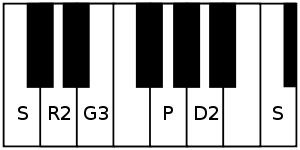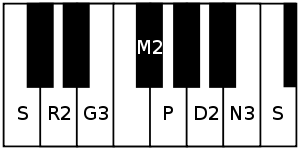Mohanakalyani
| Arohanam | S R₂ G₃ P D₂ Ṡ |
|---|---|
| Avarohanam | Ṡ N₃ D₂ P M₂ G₃ R₂ S |
| Carnatic music |
|---|
Tanjavur-style Tambura |
| Concepts |
| Compositions |
| Instruments |
|
Mohanakalyani is a rāgam in Carnatic music (musical scale of South Indian classical music). It is a janya rāgam (derived scale) from the 65th melakarta scale Mechakalyani. It is a janya scale, as it does not have all the seven swaras (musical notes) in the ascending scale. It is a combination of the pentatonic scale Mohanam and the Melakarta raga scale Kalyani.[1] This ragam has a Prati Madhyamam equivalent of Bilahari, the janya of 29th Melakartha Dheerashankarabharanam. The equivalent of Mohanakalyani in Hindustani music is Bhoop Kalyan or Shuddha Kalyan.[2] Bhoop Kalyan belongs to the Kalyan thaat of Hindustani music. Similar to Mohanakalyani, Bhoop Kalyan is a combination of Bhoop and Kalyan.[2]
Structure and Lakshana


Mohanakalyani is an asymmetric rāgam that does not contain madhyamam or nishādham in the ascending scale. It is an audava-sampurna rāgam (or owdava rāgam, meaning pentatonic ascending scale).[1][2] Its ārohaṇa-avarohaṇa structure (ascending and descending scale) is as follows:
- ārohaṇa : S R₂ G₃ P D₂ Ṡ[lower-alpha 1]
- avarohaṇa : Ṡ N₃ D₂ P M₂ G₃ R₂ S[lower-alpha 2]
The notes used in this scale are shadjam, chathusruthi rishabham, antara gandharam, panchamam and chathusruthi dhaivatham in ascending scale, with kakali nishadham and prati madhyamam included in descending scale. For the details of the notations and terms, see swaras in Carnatic music.
Popular compositions
A few compositions have been set to Mohanakalyani rāgam. Here are some popular kritis composed in Mohanakalyani.
- Saeve Srikantham by Swati Tirunal
- BhuvanEshwariya by Muthiah Bhagavatar
- Siddhi vinayakam seveham by Muthiah Bhagavatar
- Thaka thajanu theemtha, a thillana by Lalgudi Jayaraman
- Aadinaye Kanna by M. L. Vasanthakumari[3]
- Tamaddam Taggadaiyya by Lalgudi Gopala Iyer
Related rāgams
This section covers the theoretical and scientific aspect of this rāgam.
Scale similarities
- Mohanam has a symmetric pentatonic scale, with the notes same as the ascending scale of Mohanakalyani. Its ārohaṇa-avarohaṇa structure is S R2 G3 P D2 S : S D2 P G3 R2 S
- Bilahari is a rāgam which has the shuddha madhyamam in descending scale (descending scale of Shankarabharanam) in place of the prati madhyamam. Its ārohaṇa-avarohaṇa structure is S R2 G3 P D2 S : S N3 D2 P M1 G3 R2 S